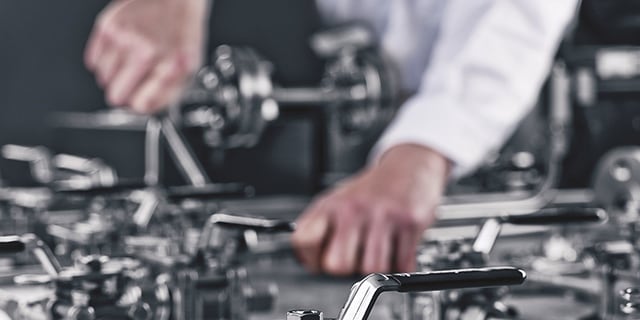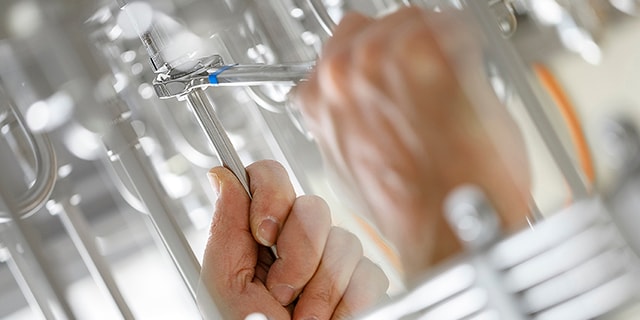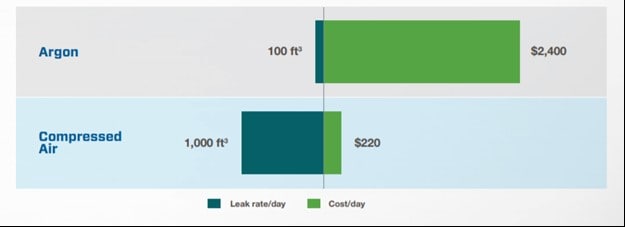4 Strategies to Maximize Industrial Fluid System Efficiencies

4 Strategies to Maximize Industrial Fluid System Efficiencies
Cory Cottrill
You have a lot of responsibilities—running your plant safely and efficiently, maximizing throughput, reducing costs, and avoiding downtime. Like most plant managers and engineers, you may not have all the resources you need to manage these responsibilities as well as new challenges as they arise.
When Swagelok field engineers work on-site with our customers, we often discuss several go-to strategies we find effective for uncovering additional fluid power system efficiencies—without increasing the workload. Below we’ll address how to identify these strategies and start implementing them within your own plant and industrial fluid systems.
Pick Your Battles Against Leaks
If leaks are a common occurrence in your facility, you are not alone. We find leaks in the majority of plants we visit—and they can be a major drain on plant efficiency. Every hiss of compressed air escaping from lines or steam leaking from end connections reduces profitability and increases maintenance costs. It may not be feasible, however, to address every leak in your plant at once.
Instead, create a roadmap that helps eliminate leaks over time by prioritizing them based on factors such as the size of the leak, the rate of loss, and the process fluid. For example, compressed air costs far less than argon. Even if your plant is losing over 1,000 ft3 of compressed air per day compared to only 100 ft3 of argon per day, prioritizing the argon leaks could save you thousands of dollars. A site audit that includes a root cause analysis and a detailed assessment of your plant’s fluid systems and components can help identify and prioritize areas of improvement to help you realize substantial cost savings.
In this hypothetical example, the argon leak would take priority – even though the compressed air leak is bigger.
Increase Fluid System Component Life Expectancy
The longer a component performs reliably in service, the less time your maintenance staff needs to spend making costly repairs. Consider a ball valve used for an on-off control in an instrumentation line. If that valve leaks persistently, maintenance technicians may need to often adjust or repair the valve, taking them away from other important duties and tasks. And if that valve fails, your team may need to shut down the entire process to replace it. A single valve could become a significant strain on your plant’s resources and productivity.
Why is my fluid system component failing?
When a component requires frequent repairs or replacement, Swagelok field engineers often discover it’s not the right product for the application. This could be due to several reasons, including:
- The component is not designed for its intended function.
- The component is not made with the right materials.
- The component does not have the service life potential required for the design specifications.
All operating conditions of your fluid system should be taken into account when selecting a component, including temperature, pressure, ambient conditions, process fluids, and vibration. Specifying the right fluid system component at the outset—or making a strategic change later based on your operational history—can save a great deal of maintenance hours while increasing operational uptime.
Simplify the Design
Choosing fully fabricated fluid system assemblies rather than individual components can also bring efficiency to your plant by simplifying the design and assembly operations. Custom fluid systems help create a fully documented system, making it easier to acquire and assemble parts, as well as ensure consistency across facilities.
Take this simple example: A plant’s staff needs to assemble a standard sampling system with 135 different part numbers, requiring about 54 hours of assembly time. Building the same system with preassembled modules would require only 17 individual part numbers and approximately 6 hours of assembly time. The result of this simple adjustment is a 90% reduction in assembly time and almost 48 hours’ worth of resources directed to other critical tasks.
If your design engineers are short on manpower, Swagelok® Custom Solutions experts can help design the ideal, high-quality fluid system assemblies for your plant’s needs. Learn how to get started.
Prepare for the Unexpected
Even with the right components, equipment failure can happen, leading to downtime at your plant. Because even the smallest delay can reduce a plant’s efficiency, you need to be ready. That’s why it’s a good idea to keep an inventory of spare parts on-site, including parts that are critical to a process and to safety, as well as specialty components with long lead times. Consider a vendor managed inventory program for additional peace of mind. Asking your supplier to organize, stock, and maintain your spare parts inventory means one less task for your team, which can now focus more of their time on maintaining productivity.
By prioritizing leaks, specifying the right fluid system components, simplifying your design and assembly operations, and keeping a well-stocked inventory of spare parts, you can set your plant up for optimal efficiency. These recommended strategies are reasonably simple and cost-effective but result in significant value for your plant.
Having the right fluid system components at the right time can play a big role in maintaining plant efficiency.
For help with industrial fluid system assemblies, product selection, or vendor managed inventory, contact your local Swagelok sales and service center.
Related Blogs

Industrial Hose Replacement: Core Tube Material Considerations
When selecting an industrial hose, the first place to start is the core tube—the hose’s innermost layer. Learn how to select the ideal hose for your application with information on core tube materials & wall construction from the experts at Swagelok.

Common Causes and Costs of Fluid System Leaks
The smallest leak can present a serious issue when maintaining your plant’s safety and profitability. Understand how and why leaks occur, how to locate and test for them, and ultimately how to develop a strategy to address and reduce leaks plant-wide.

How to Select the Right Hose Reinforcement
Industrial hoses typically contain critical reinforcement layers that contribute to longevity and performance. Learn about different reinforcement layers types and which is best suited for different fluid system applications.


